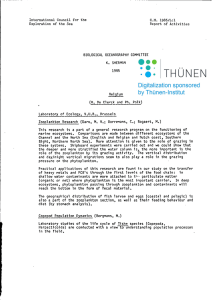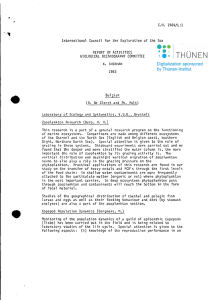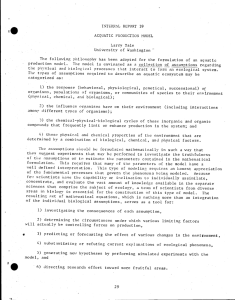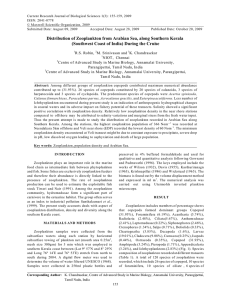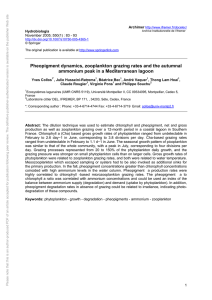016
advertisement
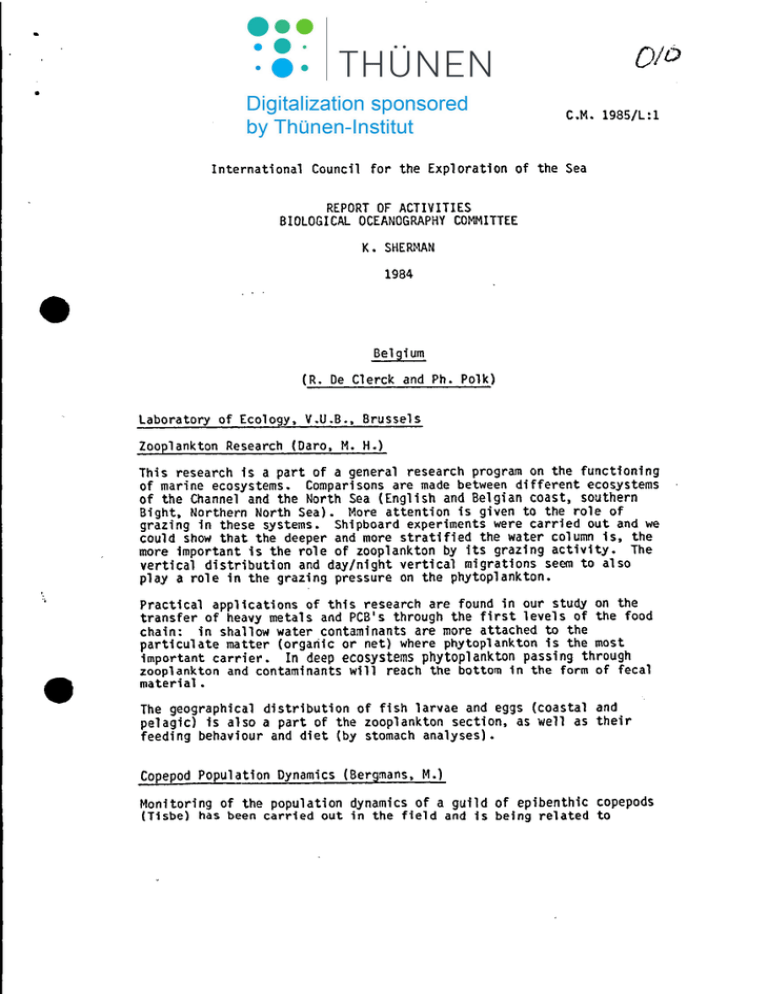
016 C.M. 1985/L:1 International Counci1 for the Exploration of the Sea REPORT OF ACTIVITIES BIOLOGICAL OCEANOGRAPHY COMMITTEE K. SHERMAN 1984 Be1gium eR. De C1erck and Ph. Polk) Laboratory of Eco10gy, V.U.B., Brusse1s Zooplankton Research (Daro, M. H.) This research is apart of a general research program on the functioning of marine ecosystems. Comparisons are made between different ecosystems of the Channel and the North Sea (English and Be1gian coast, southern Bight, Northern North Seal. More attention is given to the role of grazing in these systems. Shipboard experiments were carried out and we could show that the deeper and more stratified the water column is, the more important is the ro1e of zooplankton by its grazing activity. The vertica1 distribution and day/night vertical migrations seem to also playa role in the grazing pressure on the phytoplankton. • Practical applications of this research are found in our study on the transfer of heavy metals and PCB's through the first levels of the food chain: in sha1low water contaminants are more attached to the particulate matter (organic or net) where phytoplankton is the most important carrier. In deep ecosystems phytoplankton passing through zooplankton and contaminants will reach the bottom 1n the form of feca1 material. The geographical distribution of fish 1arvae and eggs (coastal and pe1agic) is also apart of the zooplankton section, as we1l as their feeding behaviour and diet (by stomach ana1yses). Copepod Population Dynamics (Bergmans, M.l Monitoring of the population dynamics of a guild of epibenthic copepods (Tisbe) has been carried out in the field and is being related to -2- laboratory studies of the life cycle. Special attention is given to the following aspects: (i) knowledge of the reproductive performance in an "ecological vacuum" (yielding null hypotheses on growth rates and age distribution in the field by excluding competition and predation effects); (ii) the possibility of adaptive fine-tuning of the life cycle (including effects on "r" and the "net reproductive rate") as a function of demographic conditions, i.e. in expanding, stable and declining popul ati ons. Non-living Particular Organic Matter (Pissierssens, P.) little is known about the role of Non-living Particular Organic Matter (detritus) in the Food Mass of marine copepods. Therefore, our research is concentrated on three aspects: 1) Study of the NlPOM distribution in the Belgian Coastal Zone (time, space). 2) Estimation of the contribution of the NlPOM to the total Food Mass of marine copepods. 3) Study of the origin and composition of the NLPOM. The Influence of Temperature on the Biological Compartments In Sea (Bossicart, M.I Primary Productlon (Joiris, C. and A. Bertels) 1) Incubation under fluctuating light conditions, in order to obtain a better evaluation of the real .!!!.~ net production. 2) Determination of phytoplanktonic respiration: in order to determine its relative role in total planktonic respiration. Seabirds Quantitative Distribution, in Connection with Öceanolog1cal and Ecologlcal Parameters (Jolrls, C.) Ecotoxicological Marine Research (Joiris, C., K. Delbeke and W. Overloop: dIenst Ecotoxlcologle) 1) Estimation of transfer and biomagnification mechanisms of organochlorine residues and mercury in marine ecosystems (TPM, zooplankton, fish, birds, sediments) and integrating the results on contaminatfon to biological activitfes (~. cyclusl. 2) Comparison of the contamination level of coastal ecosystem with the Atlantic ecosystem. 3) Estimation of the evolution of the mercury contamination by analyses of seabird feathers.
